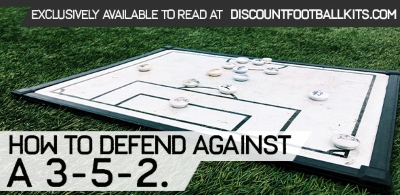Tactical trends in football tend to be cyclical, with the notion of playing with three at the back once again in vogue at elite level.
Certainly, managers like Thomas Tuchel (primarily with Chelsea) and PSG’s Christophe Galtier have deployed a 3-5-2 formation or similar variation recently, while it remains Italian coach Antonio Conte’s preferred system too.
Like any other formation, the 3-5-2 formation has a number of strengths and weaknesses, but there’s no doubt that it can be particularly hard to defend against. So, here are some ways in which you can nullify teams playing with a 3-5-2.
1. Consider Matching Up
When sides come up against particularly well-drilled and dominant opponents that deploy a 3-5-2 system, you’ll notice that they’ll often look to match up and create a similar shape.
This type of mirrored structure certainly allows you to fill the same areas of the pitch, while pitting players into direct duels and denying your opponents time and space on the ball.
This can also be effective in instances where your opponents line up with two orthodox strikers, as it creates a spare man at the back and provides additional defensive cover.
Of course, matching up man-for-man can be challenging if your opponents have superior individual quality all over the park, but it’s certainly an effective way of nullifying the collective.
2. Bypass the Midfield
Teams that play 3-5-2 or the flexible 3-4-3 variant often look to create central overloads, whether the spare central defender steps into midfield or one or more of the forwards regularly drop into the lines between midfield and attack.
This can make it hard to move the ball through midfield or maintain defensive possession, and a preferable tactic may be to bypass the middle of the park completely during transitions and when launching attacks.
Certainly, playing long passes and direct switches of play into the opponents’ fullback areas can exploit the space either side of a three-man defence, especially during transitions when the right or left wingback is pressing high.
With a defensive 4-3-3 or 4-5-1, for example, you can keep your outside attackers high and wide while leaving the full backs to go man-for-man on their opposing wing backs. This leaves continual out balls when defending and makes it hard for your opponents to sustain attacks.
3. Deploy a 4-3-3
If you want to defend aggressively against a 3-5-2 formation and press high, you may want to consider deploying a fluid and attack-oriented 4-3-3 system.
When the opposition looks to build attacks from the back, for example, your front three can compress and press man-for-man against their opposing centre halves, while your full backs can also move forward and close down their wing backs.
There’s no need to compromise on the middle of the park here, either, as you can maintain a compact, three-man midfield that also has the opportunity to go man-for-man during defensive and transitional phases.
The only issue here is potentially leaving your central defenders exposed against two centre forwards, but the idea of a high and aggressive press is to control the space against a 3-5-2 and sustain attacks over time.











Very useful